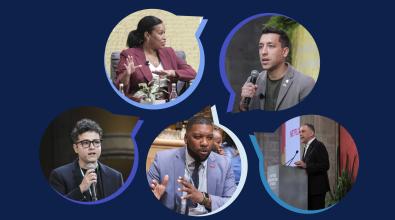How Helsinki uses a board game to promote public participation

When mayors talk about “citizen engagement,” two things usually seem clear: It’s a good thing and we need more of it. But defining exactly what citizen engagement means — and how city workers should do it — can be a lot harder than it sounds.
To make the concept real, the city of Helsinki has come up with a creative solution. City leaders made a board game that small teams of managers and front-line staff can play together. As they do so, they learn about dozens of methods for involving citizens in their work, from public meetings to focus groups to participatory budgeting.
It’s called the “Participation Game,” and over the past year, more than 2,000 Helsinki employees from all city departments have played it close to 250 times. Tommi Laitio, who heads the city’s Division of Culture and Leisure, said the game has been a surprise hit with employees because it helps cut through jargon and put public participation in concrete terms they can easily relate to.
“‘Citizen engagement’ is one of those buzzwords that gets thrown around a lot,” Laitio said. “But it means different things to different people. For some, it might mean involving citizens in a co-design process. For others, it might mean answering feedback by email. And there’s a huge difference in ambition between those approaches.”
The game’s rollout comes as Helsinki is overhauling local governance with a goal of making City Hall more responsive to the public. Starting last June, more power is vested in local political leaders, including the mayor, Jan Vapaavuori. More than 30 individual city departments are now consolidated into four. And there’s a deep new focus on involving citizens in decision making. That’s where the board game comes in.
Helsinki’s experiment is part of a wider movement both in and out of government to “gamify” workforce training, service delivery, and more. Laitio said the idea to use a board game was not about creating winners or losers, but rather to provide structure for a team meeting that sparks new ideas, collaboration, and learning. The Helsinki design firm Hellon crafted the game board and pieces in a co-creation process with about 100 city employees who tested several iterations of the game before settling on a final version.
To play the game, teams of 7 to 30 people huddle around the canvas game board with sticky notes and pens. With the help of a trained facilitator — usually a city employee who doesn’t know the participants — the group picks a concrete issue they are working on that needs more input from citizens. Then the game moves through a series of stages intended to get a dialogue going about why participation matters.
About halfway through the game, a deck of 200 cards is introduced. Printed on each card is a participation tool the city of Helsinki has used in the past — hosting resident meetings at City Hall, opening city datasets for public use, or allowing public uses in city-owned spaces, for example. Working in pairs, the group identifies tools they have used and places those cards on the board. This is an important part of the game, Laitio said.
“It builds confidence in the teams that things they have been doing are already part of the engagement work,” he said. “The idea that you’re not starting from scratch is important when you’re pushing through change in an organization.”
Later in the game, the group identifies what they can improve upon in their current engagement efforts. Then they look through the card decks to identify new methods to try. The full game takes about one and a half hours.
[Read: How Helsinki uses a card game to help residents suggest new ideas]
Virve Miettinen, a participation specialist in the Division of Culture and Leisure, has facilitated about 20 of these games and trained many of the other facilitators. She said the cards help a lot by infusing the conversation with real-world examples of participatory tools. The game is structured to surface ideas even from shy or quiet participants, she said, which adds to the sense of shared ownership at the end.
“Participation cannot be dictated,” Miettinen said. “That’s why a tool like the Participation Game is so useful. It encourages players to find their own way to put participation in practice. The game presents participation as a collective responsibility of a team rather than just a singular action or something that needs to be done to ‘tick the box.’”
Kirsi Verkka, a consultant with the city’s education department, has facilitated about 15 games. One time, she worked with a group of 13- to 16-year olds who make up a corps of youth leaders elected by students. The group came away with a goal of having more contact with Helsinki’s civil servants on issues that matter to young people, and holding more discussions with young people at youth centers around the city. “We got quite a broad view of where we are succeeding with the youth participation system and which areas we should develop,” Verkka said.
Soon, employees in other cities may be playing the game, as well. Finland’s association of municipalities is planning to make the game available for smaller cities. According to Laitio, the game is free for any city around the world to use as well, but he cautioned that it can’t simply be “copy-and-pasted” into another organization. “You need to run a design process in your own organization to adapt the game to meet your needs,” he said.
Helsinki is also among the cities participating in the Bloomberg Aspen Initiative on Cities and Autonomous Vehicles.




